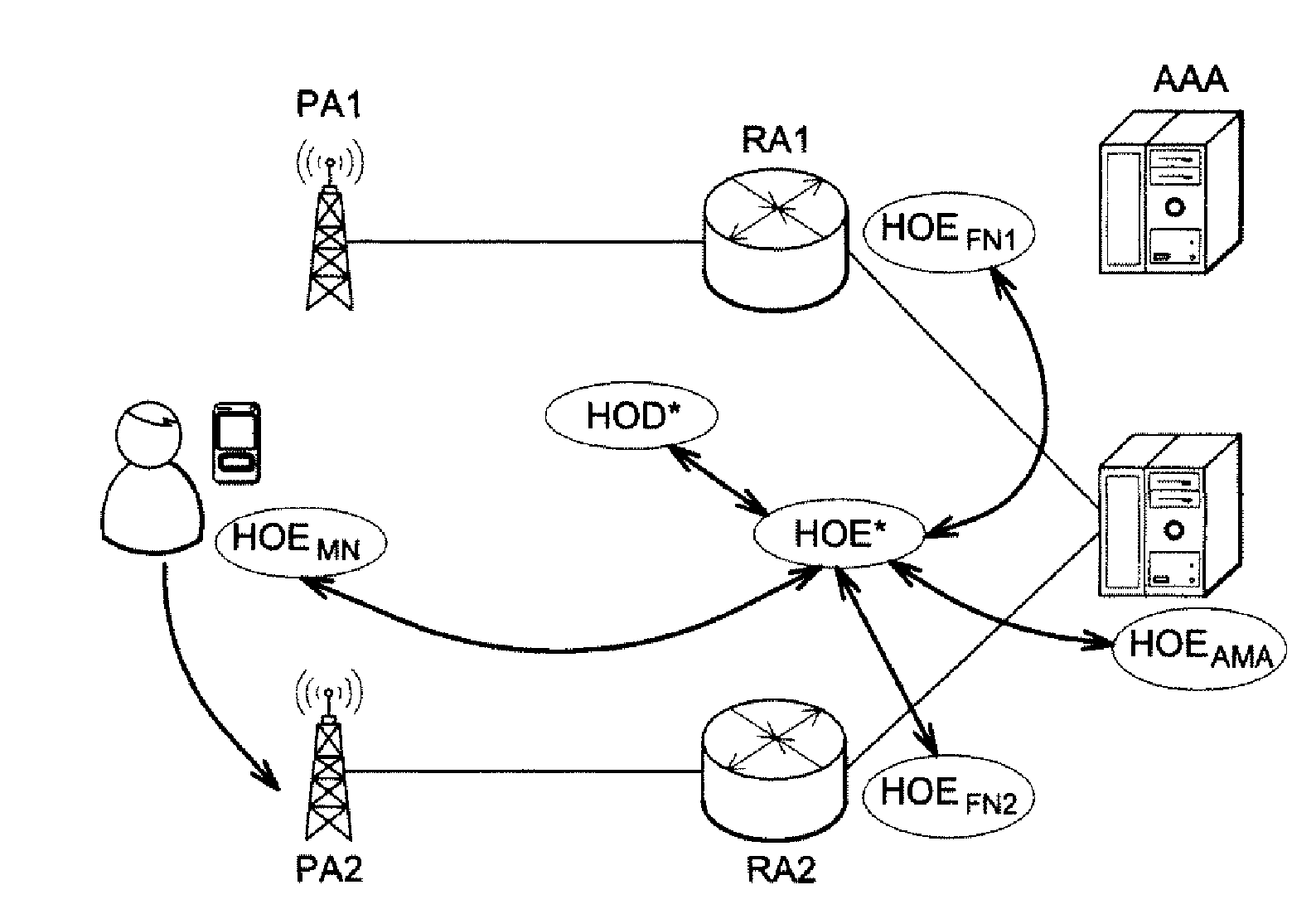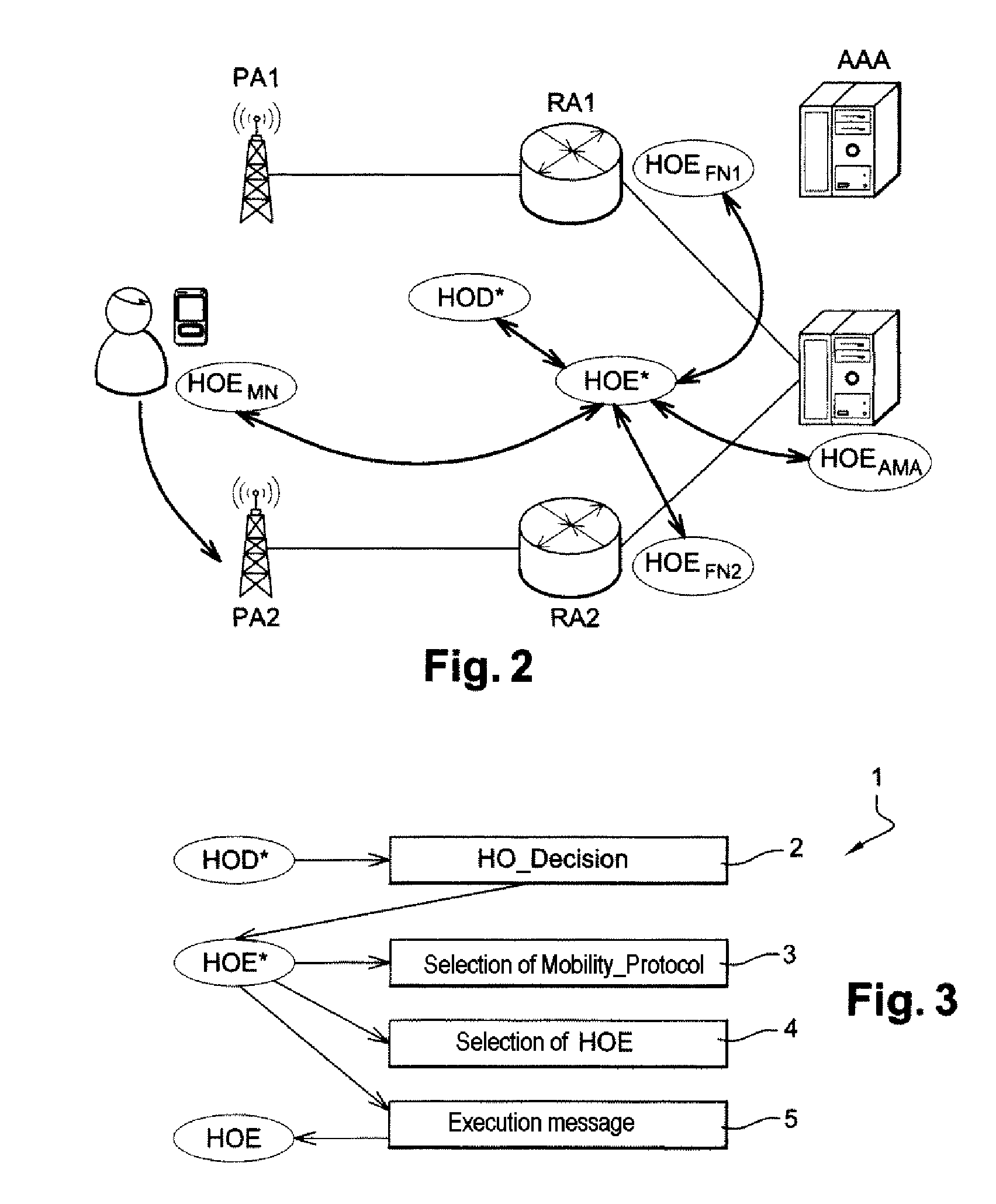Method for transferring a flow between heterogeneous access points
a flow and access point technology, applied in the field of transferring flow between heterogeneous access points, can solve problems such as the choice of mode and the decision and execution entity
- Summary
- Abstract
- Description
- Claims
- Application Information
AI Technical Summary
Benefits of technology
Problems solved by technology
Method used
Image
Examples
example 1
Switchover from a UMTS Network to a Wi-Fi Network
[0128]A handoff decision is taken by the entity HOD* to switch the traffic from the mobile MN from an access point NodeB of the UMTS network to an access point WiFi AP of the WiFi network. There are two possible scenarios: the execution is implemented by the mobile or by the network.
[0129]Scenario 1, Execution by the Mobile MN:
[0130]Implementation Context:
HOE* is collocated with HOD* (these two entities may be deployed either in the core network CN, the access network RAN, the access points AP / BS or the mobile MN).
HOE* knows that the NodeB is under the control of HOEFN2, HOEAMA1.1, HOEAMA2.1.
HOE* knows that the WiFi AP is under the control of HOEFN3, HOEAMA2.1.
a) Discovery of execution capabilities of the node FN that will manage the mobile MN:
HOE*→HOEFN3: HOE_CTX_REQ
[0131]HOEFN3→HOE*: HOE_CTX_RSP (here, FN3 responds that it does not have the capability to execute any mobility protocol)
b) Selection of the execution protocol:
HOE* knows...
example 2
Switchover from a WiFi Network to a WiMAX Network
[0139]A handoff decision is taken by the entity HOD* to switch the traffic for the mobile MN from an access point WiFi AP to an access point WiMAX AP.
[0140]Implementation Context:
HOE* is collocated with HOD* (these two entities may be deployed either in the core network CN, the access network RAN, the access points AP / BS or the mobile MN).
HOE* knows that the WiFi AP is under the control of HOEFN3, HOEAMA2.1
HOE* knows that the WiMAX AP is under the control of HOEFN4, HOEAMA1.2, HOEAMA2.1
HOEFN4 knows that it is under the control of HOEAMA1.2
HOEAMA1.2 knows that it is under the control of HOEAMA2.1
HOE* knows the identifier MN's NAI, otherwise it asks the mobile MN or a server AAA for the identifiers.
[0141]Execution Scenario:
a) Discovery of the capabilities of the nodes (FN, AMA):
HOE*→HOEFN4: HOE_CTX_REQ
[0142]HOEFN4→HOE*: HOE_CTX_RSP (here, FN4 responds that it can do PMIP)
Since HOEFN4 and the old HOEFN3 are not controlled by the same...
example 3
Switchover from a WiMAX Network to a UMTS Network
[0148]A handoff decision is taken by HOD* to switch the traffic for the mobile MN from an access point WiMAX AP to an access point NodeB.
[0149]Implementation Context:
HOE* is collocated with HOD* (these two entities may be deployed either in the core network CN, the access network RAN, the access points AP / BS or the mobile MN)
HOE* knows that the WiMAX AP is under the control of HOEFN4, HOEAMA1.2, HOEAMA2.1
HOE* knows that the NodeB is under the control of HOEFN2, HOEAMA1.1, HOEAMA2.1
HOE* knows the identifiers of the MN, otherwise it asks the MN or a server AAA for them.
[0150]Execution Scenarios:
a) Discovery of the capability of the nodes (FN, AMA):
HOE*→HOEFN2: HOE_CTX_REQ
[0151]HOEFN2→HOE*: HOE_CTX_RSP (here, FN2 responds that it can implement a GTP protocol)
Since HOEFN2 and the old HOEFN4 are not controlled by the same AMA, the HOE* enquires about the capability of AMA hierarchically above HOEFN2 (i.e., HOEAMA1.1)
HOE*→HOEAMA1.1: HOE_C...
PUM
 Login to View More
Login to View More Abstract
Description
Claims
Application Information
 Login to View More
Login to View More - R&D
- Intellectual Property
- Life Sciences
- Materials
- Tech Scout
- Unparalleled Data Quality
- Higher Quality Content
- 60% Fewer Hallucinations
Browse by: Latest US Patents, China's latest patents, Technical Efficacy Thesaurus, Application Domain, Technology Topic, Popular Technical Reports.
© 2025 PatSnap. All rights reserved.Legal|Privacy policy|Modern Slavery Act Transparency Statement|Sitemap|About US| Contact US: help@patsnap.com



